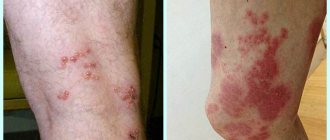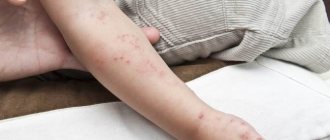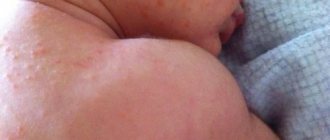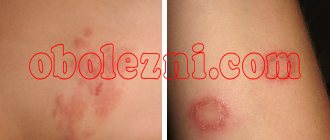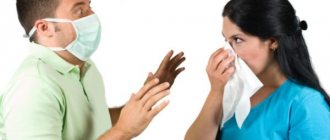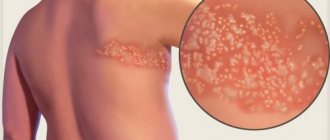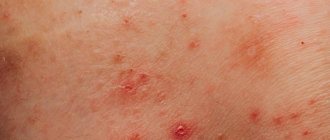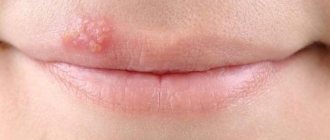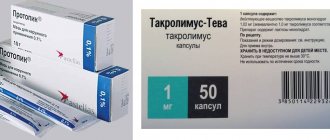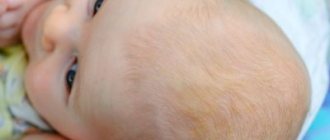Herpes in children occurs as often as in adults; its primary form is most typical. This term refers to a group of infections caused by herpes viruses of various types. The pathogen affects any organs and tissues, but most often the skin form of the disease develops. Children in the first year of life rarely get sick; their bodies contain antibodies received from their mother.
Herpes in children occurs as often as in adults; its primary form is most typical.
What does herpes look like and what virus can cause the rash?
Children usually suffer from herpes simplex virus types 1-2 and from type 3 pathogens that cause chickenpox and shingles. Less common are cases of infection with other types of herpes infection.
Let's consider the main signs characteristic of different types of herpes viruses.
Herpes simplex virus type 1 (HSV-1)
It manifests itself as rashes on the lips, facial skin, and in complicated cases – on the mucous membrane of the oral cavity (herpetic stomatitis). First, tingling, pain, burning and itching occur, then blisters filled with liquid appear. The temperature rises to subfebrile levels (37-37.5°C), and the submandibular lymph nodes may enlarge.
The child becomes lethargic, eats poorly, sometimes has abdominal pain and intestinal disorders.
The condition improves after ulceration of the vesicles. Cloudy contents leak out of them, and crusts form that bleed when damaged. Epithelization (regeneration of the skin under the ulcers) occurs after 4-7 days.
Genital herpes (HSV-2)
This type of herpetic infection is characterized by blistering rashes in the genital area, anus, and buttocks. Girls get sick more often. Infection of a child occurs in utero (from mother to fetus), during childbirth or as a result of rape.
This type of virus causes frequent relapses, especially in children with weakened immune systems.
Herpesvirus type 3
Severe intoxication, fever, vesicular watery rash all over the body, including the scalp - symptoms of chickenpox. The culprit of the disease is herpes virus type 3. Transmitted only by airborne droplets, distributed in limited children's groups (nurseries, kindergartens).
Having been ill once, the child no longer becomes infected with chickenpox.
Sometimes the virus recurs and affects nerve tissue - in this case they talk about shingles. In children, the disease begins acutely: high body temperature (up to 38-39°C), tingling, itching and pain along the nerves affected by the infection. The child develops herpes on the abdomen, in the chest area, spreading to the back. Red nodules (papules) are closely spaced and tend to cluster.
Herpes virus type 4
The pathogen of this type is called the Einstein-Barr virus. It causes infectious mononucleosis, a disease in which inflammation occurs and the lymph nodes, liver and spleen become enlarged. On days 3-5 from the onset of the disease, a pink-burgundy rash appears in the form of pigment spots; after a few days it goes away.
Mononucleosis is a highly contagious disease. If the child has been in contact with a sick person, then for 2-3 months parents should pay special attention to any ailment of the baby.
In half of the cases, the disease is asymptomatic, but the virus remains, can recur and cause long-term complications (Burkitt lymphoma).
Herpesviruses 5-8 types
One of the common diseases is cytomegalovirus infection, provoked by herpes type 5. Clinical manifestations are similar to those of acute respiratory viral infection; the virus can be detected by blood tests. Infection occurs through contact and in utero. The infection penetrates into biological fluids - saliva, blood, urine. In most children, the symptoms are erased and go away within a few days.
Herpesvirus type 6 causes roseola infantum (pseudo-rubella). The disease begins with an increase in temperature (up to 38-39°C), lethargy and tearfulness of the child. On the 3rd day, a rash appears in the form of light pink spots measuring 3-5 mm. The rash is localized on the chest, back and abdomen, without spreading to the limbs. There is no itching or peeling, the rash goes away without treatment after 2-3 days.
Herpes viruses types 7 and 8 have not been fully studied. They may manifest as increased child fatigue and low-grade fever. Usually they are in a latent state.
Prevention
Standard prevention of herpes is hygiene and protecting the child from hypothermia. Prevention of neonatal infection is somewhat more difficult. There are a number of measures:
Before planning a pregnancy, a woman should be examined. If you have herpes, it should be treated:
- The gynecologist should regularly monitor the condition of the birth canal of a pregnant woman, since herpes may recur during pregnancy;
- If an outbreak occurs before the 36th week of pregnancy, the expectant mother will be prescribed standard antiviral therapy with acyclovir. After such treatment, childbirth can occur naturally;
- If the infection appears after 36 weeks of pregnancy, a caesarean section is recommended.
After birth, the main preventive measure is long-term breastfeeding. You should not breastfeed your baby if the herpes rash is directly on her.
In the future, the child should be protected from contact with carriers of the infection. Do not allow him to come into contact with people with characteristic lip ulcers.
Why do rashes appear?
Herpes viruses penetrate into nerve cells. The tissues of the nerve fibers are surrounded by a blood-brain barrier that does not allow large molecules of chemical compounds, as well as cells of the immune system, to pass through. Therefore, herpes viruses are inaccessible to many drugs and overcome immune defenses through any method of infection.
The causes of herpes are different. Infection occurs through airborne droplets and household contact, during fetal development, during childbirth, and in rare cases, during transplantation of infected donor organs.
Factors that increase the risk of relapse:
- reduced immunity;
- hypothermia;
- lack of vitamins;
- overheating in the sun;
- physical exercise;
- frequent respiratory diseases;
- child's nervousness due to stress.
Herpes belongs to the group of opportunistic infections. Such diseases cause maximum harm during the period of weakening of the body. The virus may not detect itself for a long time, and with the slightest damage to the immune system, it may manifest itself as skin rashes and other symptoms.
How to distinguish from similar diseases with skin rashes
Differential diagnosis is carried out to exclude other diseases that have skin rashes as symptoms.
Herpes simplex types 1 and 2, as well as herpes zoster are differentiated with the following diseases:
- Allergic dermatitis. The rash is small, red, localized in the cheeks, forehead, legs and buttocks. The child has a history of a tendency to allergic reactions.
- Viral pemphigus. Characteristic are isolated oval-shaped vesicles located on the palms, soles, genitals or oral mucosa.
- Herpetic sore throat. Rashes are noted on the roof of the mouth, including the palatine arches and uvula. Do not appear on lips and skin around the mouth.
- Bullous impetigo. At the beginning of the disease, painful red spots appear in the mouth and nose. Then, in their place, superficial bubbles form, which are covered with crusts after opening.
In adolescents who are sexually active, it is necessary to differentiate genital herpes from other sexually transmitted diseases.
Parents without medical knowledge should not make the diagnosis themselves. If any rash appears on your child’s body, you should consult a doctor.
Diagnostics
Diagnostics
Diagnosis is usually carried out in a laboratory setting. These studies proceed as follows:
- finding viruses in body cells
- PCR
- REEF
These methods are very expensive. There are methods that are much cheaper and just as effective. Here are the best of them:
- serological method for determining the virus
- G-specific HSV test (this method has almost 100% probability of determining the type)
Typically, diagnosis does not even require laboratory tests, since the appearance of this viral disease is always noticeable by external signs.
Why is herpes dangerous for children?
Herpetic infection in children is more severe than in adults. Herpes on the body of a child of primary preschool age is prone to generalization of inflammation. As a result, damage to internal organs and the central nervous system is possible.
Herpes in children is, first of all, dangerous because it is prone to generalization, that is, to spread to other organs and systems, including the brain and spinal cord. Therefore, if such a complication (stupidity, convulsions) is suspected, the child should be urgently hospitalized.
If the infection has spread to the organs of vision, iridocyclitis and keratitis occur - inflammation of the iris and cornea of the eyes. Complications to the ENT organs provoke herpetic sore throat, diseases of the inner ear, and sudden deafness.
The cardiovascular system is under attack (myocarditis, atherosclerosis). Neurological complications are manifested by encephalopathies, meningitis, and damage to the nerve plexuses. Genital herpes is dangerous due to colpitis, urethritis, endometrial dysfunction and impaired reproductive functions upon reaching adulthood.
Possible complications
Herpes is a dangerous disease; if left untreated, numerous complications can arise, for example:
- unpleasant sensations in the form of pain in the lower abdomen, periodically they radiate to the lower back;
- difficulties that arise when trying to go to the toilet in a small way;
- In girls, the labia may become fused;
- secondary infectious diseases develop;
- the development of malignant tumors on the cervix or prostate in boys.
Against the background of poor health, neuroses can develop; adapting to living conditions is not easy.
Children become capricious and develop other unpleasant diseases
The cost of treatment is not high, but even this amount cannot be worth the complications that may develop. Remember, you cannot treat children on your own, and even traditional methods, no matter how effective they are, cannot be a complete replacement for traditional treatment.
How to treat
Herpes on the body in children should be treated as early as possible so that the disease does not develop into a recurrent form. Doctors will select an individual therapeutic regimen to eliminate symptoms and suppress the virus.
Drugs
The selection of medications depends on the type of herpes, age, weight and well-being of the child. Childhood herpes type 1 is treated with antiviral drugs and immunomodulators. The doctor may prescribe the following medications:
- Desensitizing and antihistamines - Suprastin, Tavegil, Diazolin.
- Vitamin complexes, fish oil.
- Antiviral agents based on interferons, Acyclovir - in the form of ointments or tablets.
- Immunomodulators - Gamma globulin, Histaglobin, Immunal, Dekaris.
Local treatment involves treating the affected areas with antiseptic and analgesic compounds, and applying antiviral ointments containing acyclovir. After crusts have formed, it is possible to apply softening oil solutions of vitamins A and E, sea buckthorn and rosehip oils.
For diseases caused by genital herpes, intravenous administration of acyclovir and immunoglobulins, Viferon in the form of suppositories, is prescribed.
Treatment of uncomplicated chickenpox consists of following a home regimen and antiseptic treatment of vesicular rashes. Drinking plenty of fluids is recommended. Sometimes antihistamines are prescribed for severe itching.
Herpes zoster requires a course of antiviral therapy with Acyclovir or Famciclovir. They should be taken no later than three days from the onset of the disease in order to reduce pain and prevent the development of neuralgia (severe pain along the nerve).
Folk remedies
Traditional medicine tips will help you get rid of the symptoms of herpes. Folk remedies must be combined with drug treatment. Use only those plants to which the child is not allergic.
Before using folk remedies, to avoid complications, consult your doctor!
Here are some examples:
- Echinacea decoction has an antiseptic, diuretic and restorative effect. Prepare it in accordance with the instructions attached to the pharmacy package. Children under one year old should not take this medicine.
- Melissa infusion is calming. Take 2 tbsp. l. dry crushed herbs, pour two glasses of boiling water, infuse and filter. Dosage – 50 ml three times a day.
- Calendula lotions relieve skin inflammation and dry out blisters. To prepare the decoction, add 2 tsp to ½ cup of boiling water. flowers.
- Alcohol tincture of propolis has anti-inflammatory and antiseptic properties. Dilute with water and wipe the sore areas.
- Sea buckthorn berry oil softens the skin and heals wounds. Use an oiled swab to lubricate the crusts formed after opening the bubbles.
- Kalanchoe leaves disinfect and reduce inflammation. Soak a cloth with fresh juice and wipe the affected areas of the skin every 2 hours.
Natural remedies are effective and available, but you should consult your doctor before using them.
Diet
Herpes on a child’s body will go away faster if you organize proper nutrition. Products containing lysine, an amino acid that suppresses the reproduction of the virus, will be beneficial. The diet should include:
- white poultry meat;
- potatoes, lentils, soy;
- reduced fat milk;
- natural yogurt, kefir;
- sea fish;
- vegetables, fruits, greens.
Peanuts, chocolate, and raisins are prohibited. They contain a lot of arginine, a substance that promotes the proliferation of herpes viruses. The diet must be complete and contain all the necessary vitamins and microelements.
Hygiene rules
During the period of exacerbation of herpetic infection, you need to ensure that the child does not touch the rash, scratch or pick off the scabs. It is necessary to wash his hands more often and lubricate his skin with an antiseptic solution.
Children must have their own towel and bed linen. Children's clothes need to be changed daily and things should be ironed with a hot iron. If there is no temperature, the child can be bathed, observing the following rules:
- Add a weak solution of potassium permanganate, decoctions of oak bark, chamomile, string, and sage to the water.
- Wash the baby quickly, no more than 5 minutes.
- Do not rub your skin with a washcloth.
- The water temperature during swimming should be comfortable.
- Older children should take a shower.
- After washing, pat the skin dry with a soft towel and treat the blisters with an antiseptic.
If rashes have formed on mucous tissues, rinsing or washing with chamomile infusion is indicated. The child’s room needs to be ventilated several times a day and wet cleaning done daily.
Treatment
In children, herpes will clear up without treatment within about one to two weeks. There are a number of ways to speed up the healing process.
Children at risk of complications are given antiviral therapy, often in hospital. To shorten the course of the disease and reduce the likelihood of spreading the virus, the doctor will prescribe oral antiviral drugs or topical agents. Systemic medications help shorten the time of illness, and creams and ointments reduce symptoms. Three antiviral drugs are available to treat herpes, namely acyclovir, valacyclovir and famciclovir. All 3 are available for oral use, but only acyclovir is available as a suspension.
- Acyclovir has the lowest bioavailability and therefore requires more frequent dosing.
- Valaciclovir and famciclovir have very good oral bioavailability and are taken once or twice daily.
Acyclovir and penciclovir are also available in ointment and cream forms, but they provide limited benefit to patients with recurrent mucocutaneous herpes infections.
Only acyclovir is prepared as a solution for intravenous administration.
Early initiation of treatment results in maximum therapeutic benefit. All 3 drugs are safe for use in children.
Other home treatments include using a cold compress or taking a pain reliever.
How long will it take to recover?
The duration of the disease depends on the type of virus, the adequacy of treatment, and the state of immunity. Blisters on the lips disappear within 4-7 days from the onset of the disease, but in weakened children, recovery is delayed up to 2 weeks.
Herpes on the body of a child with chickenpox stops producing new rashes 5-8 days after the onset of the disease. It should be remembered that the incubation period of chickenpox is up to 21 days. As soon as new elements of the rash stop forming, recovery begins.
On average, a healthy child’s body copes with the herpes virus in 10-14 days. If recovery does not occur, doctors must determine the cause of the protracted illness and change treatment tactics.
The herpes virus lives in the body of 90% of people. It is not yet possible to defeat it, but it is quite possible to prevent relapses and reduce their intensity.
Preventive measures
The child himself is practically unable to carry out all the necessary preventive measures.
A parent or other adult should closely supervise him:
- Proper personal hygiene – washing hands, using only your own things.
- Limiting contact with infected people.
- Constantly improving immunity - exercise, taking vitamins, walking in the fresh air.
- Hypothermia must not be allowed - do not walk with your child in the cold and dress him appropriately for the weather.
Let's celebrate! Although herpes is less common in children, the course of the disease is much more complicated. A fragile child’s body is not able to fight the virus on its own, so possible complications should not be allowed. Treatment should be complete and begin at the right time at an early stage.
